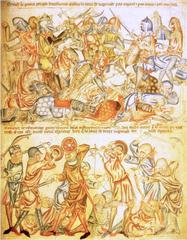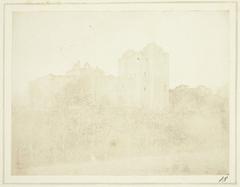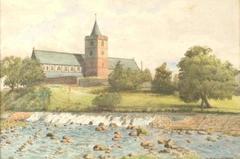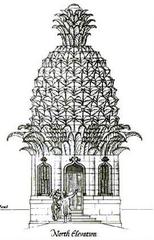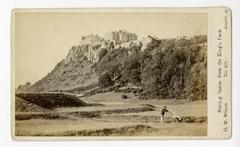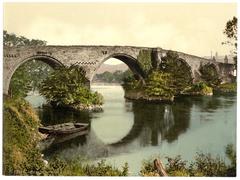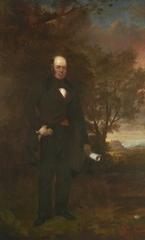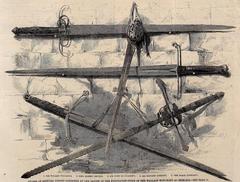Church of the Holy Rude: Visiting Hours, Tickets, and Historical Insights
Date: 31/07/2024
Introduction
The Church of the Holy Rude in Stirling, Scotland, stands as a testament to the nation’s rich historical and architectural heritage. Established in 1129 during the reign of David I, the church’s name, ‘Holy Rude,’ translates to ‘Holy Cross,’ mirroring the origin of Holyrood in Edinburgh (Wikipedia). Over its long history, the church has experienced significant events, including a devastating fire in 1405, which led to its reconstruction funded by the Lord Chamberlain of Scotland (Church of the Holy Rude). The Church of the Holy Rude is not just an architectural marvel with its Gothic arches, hammer beam roof, and Scots pillars, but also a site of profound royal connections. Notably, it was the venue for the coronation of the infant King James VI in 1567, an event officiated by John Knox, a pivotal figure in the Scottish Reformation (Church of the Holy Rude). This introduction aims to guide visitors through the church’s rich history, architectural significance, and practical visitor information, ensuring a comprehensive understanding of this historic gem.
Table of Contents
- Introduction
- Early Beginnings and Royal Connections
- Preservation and Renovation
- Visitor Experience
- Nearby Attractions
- Frequently Asked Questions (FAQ)
- Conclusion
Early Beginnings and Royal Connections
Foundation and Early History
The Church of the Holy Rude was founded in 1129 during the reign of David I, making it one of Scotland’s most ancient and revered churches. The name ‘Holy Rude’ translates to ‘Holy Cross,’ referring to the True Cross on which Jesus was crucified, sharing an origin with Holyrood in Edinburgh (Wikipedia). The original church was destroyed in a catastrophic fire in March 1405, which also devastated much of Stirling. Following this disaster, a grant from the Lord Chamberlain of Scotland facilitated the construction of a new church. The Nave, South Aisle with rounded Scots pillars, Gothic arches, and the original oak-timbered roof were completed around 1414 (Church of the Holy Rude).
Architectural Significance
The Church of the Holy Rude is renowned for its architectural features. The oak-timbered roof, completed in the early 1400s, is the oldest surviving example of a hammer beam roof in Scotland. This magnificent structure is held together by wooden pegs or dowels, showcasing the craftsmanship of the period (Church of the Holy Rude). The church’s Gothic arches and rounded Scots pillars are also notable. These elements reflect the architectural styles prevalent during the early 15th century. The chancel and tower were added in the 16th century, further enhancing the church’s grandeur (Wikipedia).
Royal Connections
The Church of the Holy Rude has a rich history intertwined with the Scottish monarchy. Stirling Castle, located adjacent to the church, was a favored residence of the Scottish monarchs and was developed as a Renaissance palace during the reigns of the later Stewart kings. Consequently, the Church of the Holy Rude became associated with the Scottish monarchy, hosting several royal events, including baptisms and coronations (Church of the Holy Rude). One of the most significant events in the church’s history was the coronation of the infant King James VI on July 29, 1567. This ceremony was conducted by John Knox, a leading figure in the Scottish Reformation. The coronation was necessitated by the abdication of Mary Queen of Scots in favor of her son, James VI, marking a pivotal moment in Scottish history (Church of the Holy Rude).
The Reformation and Beyond
The Church of the Holy Rude played a crucial role during the Reformation. By the time of James VI’s coronation, the church had become a reformed place of worship. John Knox’s sermon during the coronation emphasized the Protestant victory over Catholic influences, symbolizing the church’s alignment with the new religious order (Church of the Holy Rude). The church’s connection to the monarchy continued into the modern era. On May 24, 1997, Queen Elizabeth II attended a re-enactment of the coronation of James VI and unveiled a commemorative inscription to mark the event. This ceremony highlighted the church’s enduring significance in British history (Church of the Holy Rude).
Preservation and Renovation
Over the centuries, the Church of the Holy Rude has undergone several renovations to preserve its historical and architectural integrity. From the mid-1950s to the early 1980s, significant efforts were made by the congregation to maintain the ancient fabric of the church. A major renovation project began on September 14, 1987, coinciding with Holy Rude Day. This project was planned in three phases, starting with the West Tower, progressing through the Nave and Crossing, and finishing with the Chancel and Apse. The renovation was completed in early 1993, ensuring the church’s preservation for future generations (Church of the Holy Rude).
Visitor Experience
Visiting Hours and Tickets
Today, the Church of the Holy Rude remains a living church and a significant tourist attraction. Visitors can explore its rich history, stunning architecture, and royal connections. The church is open to visitors from March 27, with ticket prices set at £5.00 for adults and £4.00 for concessions. Children under 12 can enter for free (Church of the Holy Rude).
Accessibility
The church is fully accessible, with ramps in place to accommodate visitors with mobility issues. However, there are no toilet facilities within the church; staff will direct visitors to the nearest facilities. The church’s location at the top of Stirling’s Old Town offers a splendid view and easy access to other historical sites, including Stirling Castle (Church of the Holy Rude).
Special Events and Guided Tours
The Church of the Holy Rude hosts various special events throughout the year, including concerts, lectures, and seasonal services. Guided tours are available and provide visitors with in-depth insights into the church’s history, architecture, and royal connections. Photography enthusiasts will find numerous picturesque spots within and around the church, making it a perfect location for capturing memories.
Nearby Attractions
Stirling Castle
Just a short walk from the Church of the Holy Rude, Stirling Castle is one of Scotland’s most historically significant sites. The castle offers stunning views, beautifully restored rooms, and interactive exhibits that bring Scotland’s history to life.
Argyll’s Lodging
This 17th-century townhouse is a fine example of Renaissance architecture. Argyll’s Lodging was built for a wealthy merchant and later acquired by the Earl of Argyll. It provides a fascinating glimpse into the lifestyle of Scotland’s nobility during that period.
Smith Art Gallery & Museum
A short stroll from the church, the Smith Art Gallery & Museum offers a treasure trove of local history, art, and culture. The museum’s exhibits range from prehistoric artifacts to contemporary art.
Mar’s Wark
Located very close to the church, Mar’s Wark is the ornate facade of a Renaissance townhouse commissioned by the Earl of Mar in 1569. Although now in ruins, it remains an impressive example of Renaissance architecture.
Cowane’s Hospital
Built in 1637 as an almshouse by the merchant John Cowane, Cowane’s Hospital is a significant historical building. Although it has been closed since 2015, there are plans to restore it, making it a site of interest for those fascinated by historical architecture.
Tolbooth
Originally built in 1705 as Stirling’s administrative center, the Tolbooth now serves as an arts venue. It hosts a variety of performances, exhibitions, and workshops, making it a vibrant cultural hub in the heart of Stirling.
Mercat Cross
The Mercat Cross, topped with a unicorn known as the ‘Puggie,’ was once the focal point of Stirling’s bustling market. It remains a significant historical landmark and a great spot for photos.
Old Town Jail
This Victorian prison building, which lay derelict from the 1960s until its reopening as a visitor attraction in 2015, offers guided tours led by costumed guides. The Old Town Jail provides a fascinating look into the harsh realities of 19th-century prison life.
Falkirk Wheel
A short drive from Stirling, the Falkirk Wheel is a modern engineering marvel. This rotating boat lift connects the Forth and Clyde Canal with the Union Canal, raising vessels 115 feet. It is a must-see for engineering enthusiasts and offers boat trips for visitors.
Scone Palace
Although a bit further afield, Scone Palace is well worth the trip. This historic site was the crowning place of Scottish kings, including Macbeth. The palace and its grounds offer a rich blend of history, architecture, and beautiful gardens.
Glasgow Cathedral
A visit to Glasgow Cathedral is a journey into medieval Scotland. The dark, imposing interior and stunning architecture make it a must-see for history and architecture enthusiasts.
Riverside Museum
Located in Glasgow, the Riverside Museum is a visually impressive modern museum designed by the late British-Iraqi architect Zaha Hadid. It houses a vast collection of transport-related exhibits, making it a fascinating visit for all ages.
Mackintosh House
Also in Glasgow, the Mackintosh House is a reconstruction of the first home that Charles Rennie Mackintosh bought with his wife. It offers a unique insight into the life and work of this renowned designer.
Kelvingrove Art Gallery & Museum
Another Glasgow highlight, the Kelvingrove Art Gallery & Museum is housed in a magnificent sandstone building. It features a diverse range of exhibits, from fine art to natural history, making it a cultural treasure trove.
Paisley Abbey
A short trip from Glasgow, Paisley Abbey is a majestic Gothic building founded in 1163. It is steeped in history and offers a serene and contemplative atmosphere.
Frequently Asked Questions (FAQ)
Q: What are the Church of the Holy Rude’s visiting hours?
A: The church is open to visitors from March 27. Specific visiting hours can be found on the church’s official website.
Q: Are guided tours available at the Church of the Holy Rude?
A: Yes, guided tours are available and provide detailed information about the church’s history and significance.
Q: What is the cost of tickets to visit the Church of the Holy Rude?
A: Ticket prices are £5.00 for adults and £4.00 for concessions. Children under 12 can enter for free.
Conclusion
The Church of the Holy Rude stands as a testament to Scotland’s rich history and architectural heritage. Its early beginnings, royal connections, and role in the Reformation make it a site of immense historical significance. Visitors to the church can immerse themselves in centuries of history, exploring the very place where kings were crowned and history was made. Don’t miss the chance to visit this remarkable site and experience its timeless beauty. For more information and to plan your visit, check out related posts and follow our updates on social media.
References
- Church of the Holy Rude. (n.d.). Retrieved July 31, 2024, from https://www.churchoftheholyrude.co.uk/about-the-church/
- Church of the Holy Rude. (n.d.). Retrieved July 31, 2024, from http://www.holyrude.org/styled-8/index.html
- Undiscovered Scotland. (n.d.). Retrieved July 31, 2024, from https://www.undiscoveredscotland.co.uk/stirling/holyrude/index.html
- Wikipedia. (n.d.). Church of the Holy Rude. Retrieved July 31, 2024, from https://en.wikipedia.org/wiki/Church_of_the_Holy_Rude
